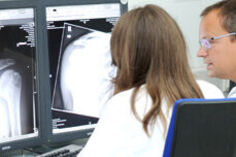Scientific Project Management
Research Infrastructure
YACTA

YACTA - Automatic lung CT image quantification tool
The software system YACTA (Yet Another CT Analyzer) is a well-known research tool for the fully automatic lung CT image quantification, a tool that makes big data analysis possible.
Lung CT scans can be analyzed via Windows Explorer context menu, batch files, DICOM transfer (YACTA as DICOM node) or in GUI mode. The default quantification procedures work without any user interaction. Quantification results are pushed in a SQL database.
Different quantitative CT (QCT) techniques are implemented to measure structural and functional changes in the lung parenchyma and in the tracheobronchial tree. The automatic parenchyma analysis includes e.g. a lobe-based analysis of emphysema, air trapping or the application of the registration-based parametric response map (PRM) method. The automatic analysis of the bronchial tree determines the lumen and wall areas of all segmented bronchi by using a precise integral-based method (IBM) and derives parameters such as an average wall percentage, Pi10 or a bronchiectasis index.
Contact person: Oliver Weinheimer
Publications:
- Katie J. Bayfield*, Oliver Weinheimer*, Christie Boyton, Rachel Fitzpatrick, Anna Middleton, Brendan Kennedy, Anneliese Blaxland, Geshani Jayasuriya, Neil Caplain, Hana Issa, Robert Goetti, Mark O. Wielpütz, Lifeng Yu, Craig J. Galban, Terry E. Robinson, Brian Bartholmai, Dominic Fitzgerald, Hiran Selvadurai, and Paul D. Robinson. “Implementation and evaluation of ultra-low dose CT in early cystic fibrosis lung disease”. In: The European respiratory journal : official journal of the European Society for Clinical Respiratory Physiology 62.1 (June 2023). issn: 1399-3003. doi: 10.1183/13993003.00286-2023.
- Philip Konietzke, Mark O. Wielpütz, Willi L. Wagner, Felix Wuennemann, Hans-Ulrich Kauczor, Claus P. Heussel, Monika Eichinger, Ralf Eberhardt, Daniela Gompelmann, and Oliver Weinheimer. “Quantitative CT detects progression in COPD patients with severe emphysema in a 3-month interval”. In: European Radiology (Jan. 2020). issn: 0938-7994. doi: 10.1007/s00330-019-06577-y.
- Oliver Weinheimer, Tobias Achenbach, Carsten Bletz, Christoph Düber, Hans-Ulrich Kauczor, and Claus Peter Heußel. “About Objective 3-D Analysis of Airway Geometry in Computerized Tomography”. In: IEEE Trans. Med. Imaging 27.1 (Jan. 2008), pp. 64–74.
ADIT
ADIT (Automated DICOM Transfer) is a powerful tool that allows users to exchange DICOM data seamlessly between different systems. With its user-friendly web interface, ADIT provides a variety of features such as transferring DICOM data between DICOM/PACS servers, downloading DICOM data to local or network folders, and pseudonymizing DICOM data on the fly. Additionally, ADIT allows users to specify a trial name for the transferred data, making it easy to identify. Selective Transfer mode enables users to use the web interface to select studies for transfer or download, with the option of downloading the data to an encrypted 7-Zip archive. Batch Query and Batch Transfer modes provide users with the ability to upload batch files to make multiple queries on a DICOM server or transfer/download multiple studies. ADIT also allows users to define when transfers should occur to reduce PACS server load and offers fine-grained control over user permissions. With detailed help modals, ADIT is an all-in-one solution for efficiently managing DICOM data transfers.
Contact person: Manuel Debic
REDCap
REDCap (Research Electronic Data Capture) is a web-based application specifically designed to streamline the process of building and managing online surveys and databases, including sensitive health data. The platform comprises key components such as project creation, data collection instruments, user management, data quality checks, and reporting.
To effectively manage REDCap within a healthcare environment, it is crucial to establish a structured infrastructure that prioritizes data security and patient privacy. This would include responsibilities like system administration for software updates, backups, and secure data storage; project management for overseeing project design and data analysis while maintaining compliance with healthcare regulations; user management for maintaining user accounts, providing training, and ensuring role-based access controls; data quality and compliance for ensuring data privacy, security; and reporting for developing custom reports and supporting data interpretation in a secure and compliant manner.
Contact Person: Shengkai Zhao
XNAT
XNAT is an open-source platform for managing and analyzing medical imaging data. It provides a centralized repository, secure data sharing, analysis tools, and extensibility for multi-site collaborations. With its user-friendly interface, XNAT simplifies data management and supports various imaging modalities. It is widely used in medical research and clinical settings for efficient data storage, sharing, and advanced analysis capabilities.
Contact person: Manuel Debic
SAIL
The Small Animal Imaging Laboratory (SAIL) is a research facility centered around advanced imaging capabilities. Anchored by an in vivo Bruker Micro-CT, Model SkyScan 1176, SAIL offers a dynamic environment for conducting both in vivo and ex vivo experiments. The micro-CT scanner is equipped with a range of tools that ensure precise positioning of subjects, enabling researchers to explore anatomical and functional insights. Our mission is to provide state-of-the-art imaging resources that catalyze scientific research at the intersection of microradiology, radiology, pathology, and the intricate realms of clinical and pre-clinical research.
SAIL plays a pivotal role in facilitating research initiatives within the TLRC (Translational Lung Research Center Heidelberg) and the broader DZL (German Center for Lung Research) community. While primarily serving internal researchers, SAIL also fosters collaborations with external partners who share our vision.
Contact scientists: Prof. Mark Wielpütz, Dr. Willi Wagner
Contact MTA: Martin Finke









